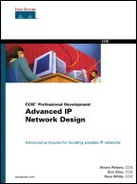DUAL Operation
Typical distance vector protocols, such as RIP, use the distance (metric—in most cases, the hop count) to a destination network to determine the best path and save the vector (next hop) for only the best path. If the best path becomes unusable, the router waits until the next set of updates from each of its neighbors to find a new path (or rediscover an old path that was previously discarded).
Waiting for periodic updates to discover alternate paths to a destination slows convergence time dramatically.
For example, if the network in Figure C-1 is running RIP, Router B will choose the path to 10.1.4.0/24 by examining the hop count through each available path. Because the path through Router C is three hops, and the path through Router A is two hops, Router B will choose the path through Router A and discard the alternate path it learned through Router C.
Figure C-1. Choosing the Best Route in an RIP Network

If Router A's path to 10.1.4.0/24 fails, Router B will continue believing that the best route to this destination is through Router A until it hasn't heard about 10.1.4.0/24 from Router A for three update periods (90 seconds in RIP). Once Router B has timed out the router through Router A, it must wait for Router C to re-advertise the route (which occurs every 30 seconds in RIP). Not including any hold-down time, it could take between 90 and 120 seconds for Router B to switch from the path through Router A to the path through Router C to reach 10.1.4.0/24.
Rather than discarding information about alternate paths, EIGRP builds a topology table from each of its neighbor's advertisements and converges by either looking for an alternate route in the topology table, or querying its neighbors if it knows of no other route.
Then, EIGRP must provide:
Some means of building and maintaining neighbor relationships. Because EIGRP doesn't periodically re-advertise routes, it relies on neighbor relationships to determine if the routes through a given neighbor are still usable.
A way of determining if a given path advertised by a neighbor contains a loop. EIGRP must be able to determine if a route is a loop so that a list of valid alternate routes is available.
A method of querying neighbors to find previously unknown paths. Split-horizon and other circumstances can cause a router not to advertise all the destinations it can reach. Because EIGRP doesn't rely on periodic updates, routers must be able to query neighbors to find alternate routes that may be hidden.
